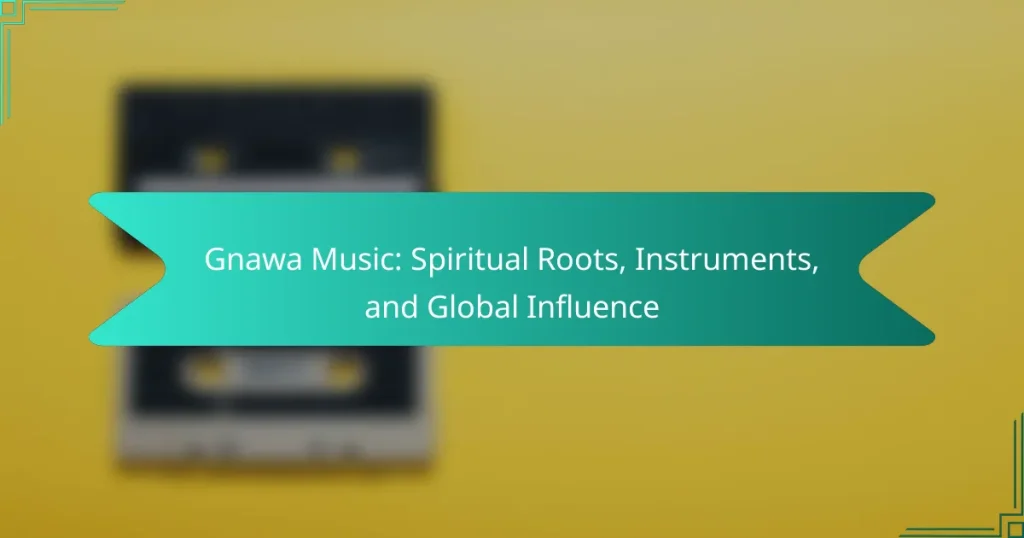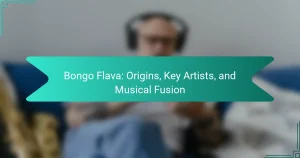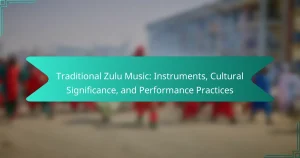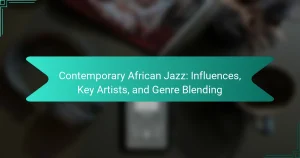Gnawa music is a traditional genre from the Gnawa people of Morocco, characterized by the use of the guembri, a three-stringed bass instrument, alongside krakebs, metal castanets that enhance its rhythmic quality. This genre blends African, Arab, and Berber musical influences, serving both spiritual and cultural purposes, particularly in healing rituals. Gnawa music has gained international recognition, influencing various global music styles and inspiring artists across genres such as jazz and rock. Festivals like the Gnawa World Music Festival in Essaouira highlight its global appeal, while collaborations with international musicians foster innovative fusions, reinforcing its cultural significance and promoting heritage preservation.
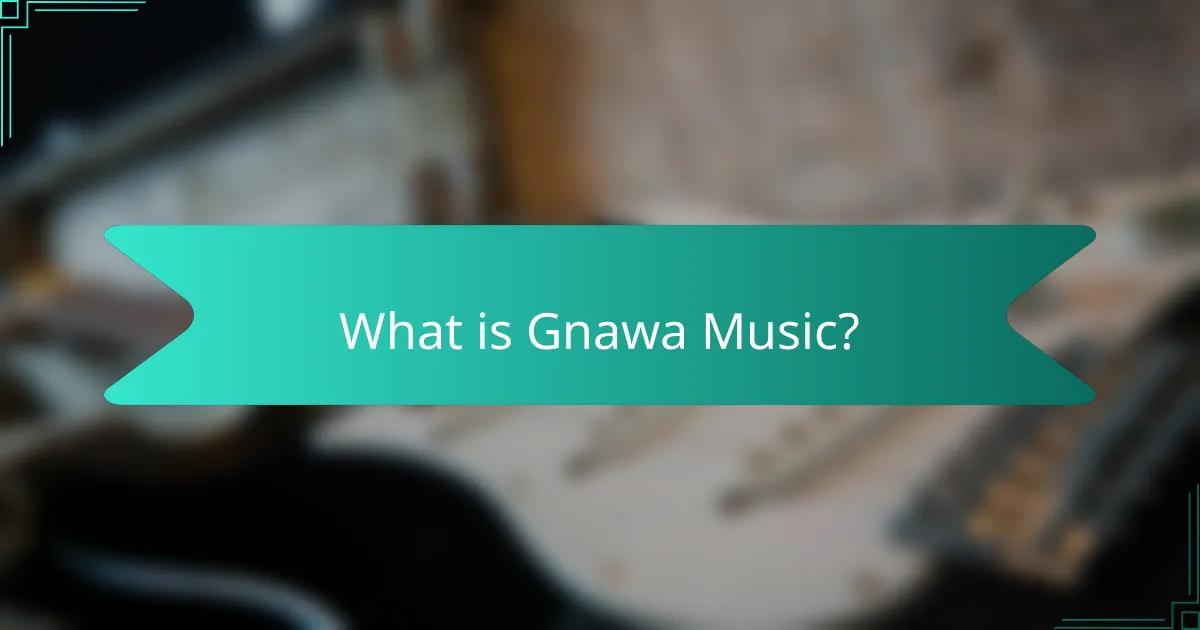
What is Gnawa Music?
Gnawa music is a traditional genre originating from the Gnawa people of Morocco. It combines African, Arab, and Berber musical influences. Gnawa music is characterized by its use of the guembri, a three-stringed bass instrument. The music often features call-and-response vocals and rhythmic handclapping. It serves both a spiritual and cultural purpose, often associated with healing rituals. The genre has gained international recognition, influencing various global music styles. Notable artists, such as Maalem Mahmoud Guinia, have popularized Gnawa music worldwide. The music reflects the rich heritage and history of the Gnawa community.
How did Gnawa Music originate?
Gnawa Music originated in Morocco among the Gnawa people, who are descendants of sub-Saharan African slaves. This music form emerged in the 16th century, blending African, Arab, and Berber musical traditions. Gnawa music served as a spiritual practice and a means of healing, often performed during rituals. The music features unique instruments such as the guembri and krakebs. Historical records indicate that Gnawa musicians were vital in preserving African cultural heritage. Their performances often involve trance-inducing rhythms and call-and-response vocals. Over time, Gnawa music has influenced various genres globally, contributing to world music. Its origins are deeply rooted in the cultural and spiritual history of the Moroccan landscape.
What cultural influences shaped the development of Gnawa Music?
Gnawa Music developed through a blend of African, Berber, and Arab cultural influences. The African influence stems from the traditions of enslaved sub-Saharan Africans. Their spiritual practices and rhythms are foundational to Gnawa music. Berber culture contributes traditional melodies and instruments to the genre. The use of the guembri, a three-stringed instrument, originates from Berber musical heritage. Arab influences are evident in the lyrical content and performance style. The incorporation of Arabic instruments and scales enhances the music’s complexity. Historical interactions, such as trade and cultural exchange, further shaped its evolution. These diverse influences create a rich tapestry that defines Gnawa music today.
How does Gnawa Music relate to Moroccan history?
Gnawa music is deeply intertwined with Moroccan history. It originated from the cultural practices of enslaved sub-Saharan Africans brought to Morocco. This music form reflects their spiritual beliefs and rituals. The Gnawa people, descendants of these enslaved individuals, use music for healing and spiritual ceremonies. Historical texts indicate that Gnawa music has been practiced in Morocco since the 16th century. It played a significant role in the cultural exchange between African and Arab traditions. The annual Gnawa World Music Festival in Essaouira highlights its historical importance. This festival attracts global audiences, showcasing Morocco’s rich cultural heritage. Thus, Gnawa music serves as a vital link to Morocco’s historical narrative.
What are the spiritual aspects of Gnawa Music?
Gnawa music embodies deep spiritual aspects tied to healing and ritual. The music is often used in ceremonies called “lila,” which facilitate spiritual possession and healing. Participants believe that the rhythms and melodies can invoke spirits, leading to a trance state. This trance state is viewed as a means of connecting with ancestral spirits for guidance and support. The use of instruments like the guembri and the krakebs enhances the spiritual experience through their unique sounds. Additionally, the lyrics often reflect themes of suffering, redemption, and the search for spiritual enlightenment. Thus, Gnawa music serves as a powerful medium for expressing and exploring [censured] within the community.
How does Gnawa Music serve as a spiritual practice?
Gnawa Music serves as a spiritual practice by facilitating healing and connection to ancestral spirits. The music involves rhythms and chants that are integral to rituals known as “lila.” These rituals aim to purify participants and evoke spiritual possession. The use of traditional instruments like the guembri and krakebs enhances the spiritual atmosphere. Participants often enter trance states during performances, allowing for deep emotional release. The communal aspect of Gnawa gatherings fosters a sense of belonging and shared [censured]. Historical accounts indicate that Gnawa practices originated from West African traditions, emphasizing their roots in spiritual healing. The music’s role in spiritual practices has been recognized in various studies, highlighting its importance in cultural identity and emotional well-being.
What role do rituals play in Gnawa Music performances?
Rituals play a central role in Gnawa music performances. They serve as a means of spiritual healing and connection to ancestral spirits. The performances often involve trance-inducing rhythms and repetitive melodies. These elements facilitate a communal experience among participants. Rituals also include the use of traditional instruments like the guembri and krakebs. The guembri, a three-stringed bass, is essential for setting the tone. Krakebs, metal castanets, add rhythmic complexity to the music. Together, these instruments enhance the ritualistic atmosphere. The integration of dance further deepens the spiritual experience. Overall, rituals in Gnawa music create a profound link between the physical and spiritual realms.
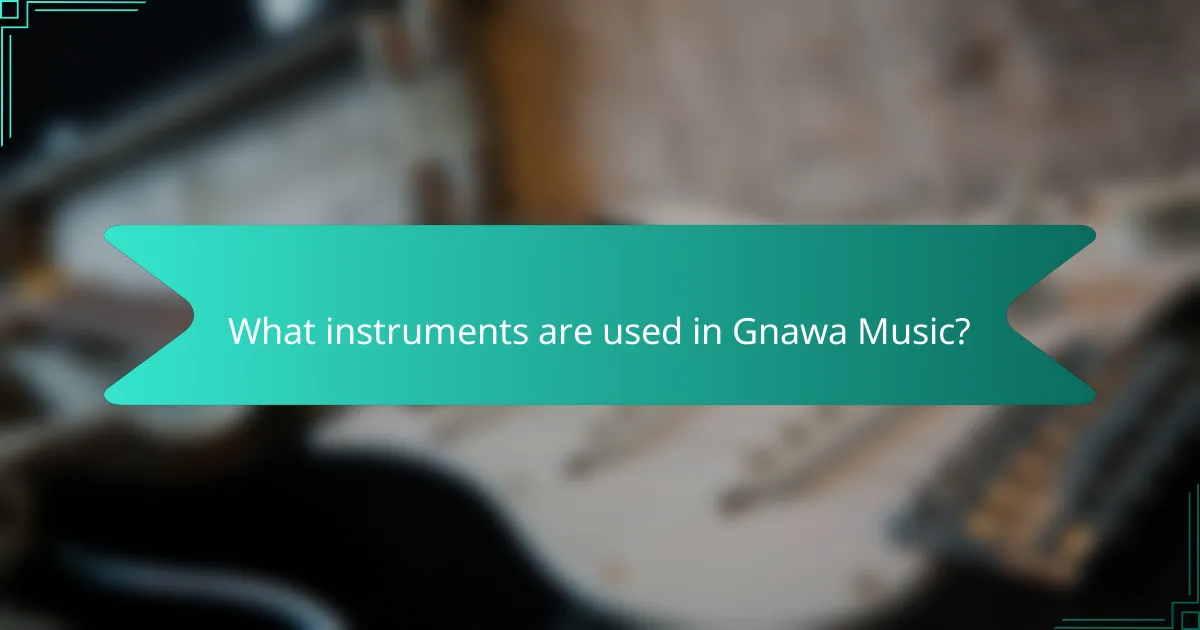
What instruments are used in Gnawa Music?
Gnawa music primarily utilizes three main instruments: the guembri, the krakebs, and the guembri. The guembri is a three-stringed bass instrument made from wood and animal skin. It provides the rhythmic and melodic foundation of the music. The krakebs are metal castanets that create sharp, percussive sounds. They are played in pairs and add a vibrant layer to the music. The guembri, krakebs, and their combination are essential for the traditional sound of Gnawa music. These instruments have deep cultural significance and are integral to the spiritual rituals associated with Gnawa practices.
How do traditional Gnawa instruments contribute to the music’s sound?
Traditional Gnawa instruments significantly shape the music’s sound through their unique tonal qualities and rhythmic patterns. The guembri, a three-stringed bass instrument, provides a deep, resonant foundation. Its low frequencies create a hypnotic backdrop that enhances the spiritual experience. The krakebs, metal castanets, introduce sharp, percussive sounds. Their clashing creates intricate rhythms that drive the music forward. Together, these instruments establish a distinctive blend of melody and rhythm. This combination is essential for the call-and-response style prevalent in Gnawa music. The interplay between the guembri and krakebs invites participation and communal engagement. Hence, traditional Gnawa instruments are vital in crafting the genre’s unique auditory identity.
What is the significance of the guembri in Gnawa Music?
The guembri is a significant instrument in Gnawa music. It serves as the primary melodic and rhythmic foundation in performances. The guembri is a three-stringed lute made from wood and animal skin. It is traditionally played during spiritual ceremonies and healing rituals. The instrument’s deep, resonant sound is believed to connect the physical and spiritual worlds. In Gnawa culture, the guembri symbolizes the ancestral heritage and cultural identity. Its use in music reflects the blend of African and Islamic influences in Gnawa traditions. The guembri also facilitates trance states during rituals, enhancing the spiritual experience for participants.
How do the krakebs enhance the performance of Gnawa Music?
Krakebs enhance the performance of Gnawa Music by providing a distinct rhythmic foundation. These metal castanets create sharp, percussive sounds that drive the music forward. Their rhythmic patterns complement the deep, spiritual melodies of the guembri, another key instrument in Gnawa. The interaction between krakebs and guembri fosters a dynamic musical dialogue. This interplay is crucial for creating the trance-like state associated with Gnawa performances. Additionally, krakebs serve a cultural role, symbolizing the connection to ancestral traditions. Their use in ceremonies emphasizes the spiritual significance of the music. Overall, krakebs are essential for both the rhythm and cultural expression in Gnawa Music.
What are the different forms of Gnawa instruments?
Gnawa instruments include the guembri, krakebs, and tbel. The guembri is a three-stringed bass instrument made from wood and animal skin. It serves as the primary melodic instrument in Gnawa music. Krakebs are metallic castanets that provide rhythmic accompaniment. They are typically played in pairs during performances. The tbel is a large drum that adds depth to the rhythm. Each instrument plays a crucial role in creating the unique sound of Gnawa music. These instruments are integral to traditional ceremonies and rituals, emphasizing their cultural significance.
What variations exist among the guembri across regions?
The guembri varies significantly across regions where Gnawa music is practiced. In Morocco, the guembri typically features a three-string design. This version often uses a wooden body made from cedar or walnut. In contrast, other regions may utilize different materials or string configurations. For instance, some guembri in Algeria may have four strings. The tuning and playing techniques also differ regionally, with variations in rhythm and style. Additionally, the decorative aspects of the guembri can reflect local cultural influences. These regional adaptations contribute to the diverse soundscapes within Gnawa music traditions.
How do different playing techniques affect the sound of Gnawa instruments?
Different playing techniques significantly affect the sound of Gnawa instruments. For instance, the use of varied plucking styles on the guembri produces distinct tonal qualities. Strumming can create a rhythmic, percussive sound, while fingerpicking results in a more melodic tone. Additionally, the pressure applied during playing alters the instrument’s resonance and volume. Techniques such as bending notes introduce emotional depth, enhancing the spiritual expression inherent in Gnawa music. Research indicates that these nuances contribute to the genre’s unique sound, allowing for a rich auditory experience that reflects its cultural roots.
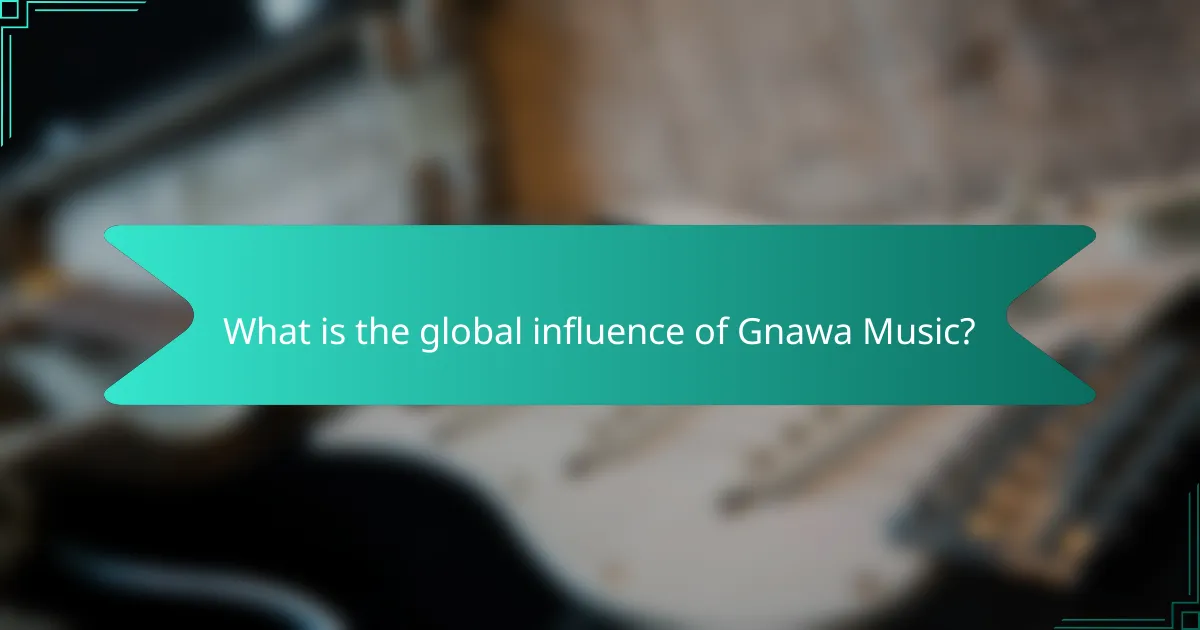
What is the global influence of Gnawa Music?
Gnawa Music has a significant global influence, merging traditional African, Arab, and Berber sounds. Originating in Morocco, it promotes cultural exchange and social cohesion. The genre has inspired various artists worldwide, including musicians in jazz, rock, and electronic music. Festivals like the Gnawa World Music Festival in Essaouira showcase its international appeal. Collaborations with global artists have led to innovative fusions, enhancing its reach. The music’s deep spiritual roots resonate with listeners, transcending geographical boundaries. Research indicates that Gnawa Music contributes to cultural identity and heritage preservation. Its rhythms and melodies continue to attract diverse audiences globally.
How has Gnawa Music impacted contemporary music genres?
Gnawa music has significantly influenced contemporary music genres, particularly in fusion and world music. Its unique rhythms and scales have been incorporated into jazz, rock, and electronic music. Artists like Robert Plant and Pharoah Sanders have drawn inspiration from Gnawa’s distinct sound. The use of traditional instruments like the guembri and krakebs has enriched modern compositions. Additionally, the spiritual and communal aspects of Gnawa music resonate in various global music movements. This cross-cultural exchange has led to collaborations that blend traditional and contemporary styles. The global reach of Gnawa music highlights its role in shaping diverse musical landscapes.
What collaborations have emerged between Gnawa musicians and global artists?
Collaborations between Gnawa musicians and global artists include notable partnerships with musicians such as Robert Plant and Randy Weston. These collaborations blend traditional Gnawa music with various genres, enhancing cultural exchange. For instance, Robert Plant’s work with Gnawa musicians showcases the fusion of rock and traditional sounds. Additionally, Randy Weston integrated Gnawa rhythms into his jazz compositions, highlighting the genre’s versatility. Other collaborations feature artists like Pharoah Sanders, who embraced Gnawa music in his jazz performances. These partnerships have helped popularize Gnawa music on international stages.
How does Gnawa Music influence world music festivals?
Gnawa music influences world music festivals by introducing unique rhythms and spiritual themes. This genre, rooted in Moroccan culture, features traditional instruments like the guembri and krakebs. Its incorporation into festivals promotes cultural exchange and diversity. Artists often collaborate with musicians from various genres, creating fusion performances. Festivals such as the Essaouira Gnawa and World Music Festival showcase these collaborations. The global appeal of Gnawa music attracts diverse audiences, enhancing festival experiences. Research indicates that its vibrant sound enhances the overall atmosphere of these events. This influence fosters appreciation for Moroccan heritage worldwide.
Why is Gnawa Music important in cultural exchanges?
Gnawa music is important in cultural exchanges because it embodies a rich blend of African, Arab, and Berber influences. This genre fosters dialogue between diverse cultures through its unique rhythms and spiritual themes. Gnawa music often incorporates traditional instruments like the guembri and the krakebs, which showcase its distinct sound. The music serves as a medium for storytelling and sharing historical experiences, particularly related to slavery and migration. Festivals and performances attract global audiences, promoting cultural appreciation and understanding. Notably, events like the Essaouira Gnawa and World Music Festival highlight its international appeal. This exchange fosters collaboration between artists from different backgrounds, enriching the global music scene.
What role does Gnawa Music play in promoting Moroccan culture abroad?
Gnawa music plays a significant role in promoting Moroccan culture abroad. It serves as a cultural ambassador, showcasing Morocco’s rich heritage. The music is characterized by its unique rhythms and spiritual themes. International festivals often feature Gnawa performances, attracting global audiences. This exposure fosters interest in Moroccan traditions and arts. Collaborations with global artists further enhance its reach. Research indicates that such cultural exchanges strengthen Morocco’s identity on the world stage. Therefore, Gnawa music not only preserves but also elevates Moroccan culture internationally.
How does Gnawa Music foster community and connection among diverse audiences?
Gnawa Music fosters community and connection among diverse audiences through its participatory nature and cultural significance. The music often involves collective participation, inviting listeners to engage through clapping, dancing, and singing. This creates a shared experience that transcends cultural and linguistic barriers. The spiritual rituals associated with Gnawa Music promote healing and unity, drawing people together in a communal atmosphere. Festivals and performances attract varied audiences, encouraging cultural exchange and appreciation. The use of traditional instruments like the guembri and krakebs enhances the immersive experience, inviting collaboration among musicians and audiences alike. Research shows that music can enhance social bonds, making Gnawa Music a powerful tool for connection.
What are some tips for experiencing Gnawa Music?
To experience Gnawa music, attend a live performance or festival. Engaging with local musicians enhances the experience. Listen to traditional instruments like the guembri and krakebs. Participate in the music by clapping or dancing. Understand the cultural significance of the music for a deeper appreciation. Explore the history and spiritual roots of Gnawa to connect with its essence. Familiarize yourself with the rhythms and melodies to enhance your listening experience. Finally, approach the experience with an open mind and respect for the traditions involved.
How can one best appreciate a live Gnawa performance?
To best appreciate a live Gnawa performance, immerse yourself in the cultural context and rhythm. Understand that Gnawa music originates from the spiritual traditions of North Africa. Engage with the performers and the audience to enhance your experience. Pay attention to the instruments, such as the guembri and krakebs, which are central to the sound. Notice the call-and-response structure that invites participation. Feel the trance-like state that the music aims to evoke. Observe the dancers, as their movements reflect the music’s spiritual essence. Overall, participation and connection deepen the appreciation of the performance.
What resources are available for learning about Gnawa Music?
Books on Gnawa music include “Gnawa: The Sacred Music of Morocco” by Eric Charry. Online platforms like YouTube feature instructional videos and performances. Websites such as World Music Network provide articles and resources. Academic journals often publish research on Gnawa music’s cultural significance. Workshops and festivals offer hands-on learning experiences. Notable festivals include the Essaouira Gnawa and World Music Festival in Morocco. These resources facilitate a comprehensive understanding of Gnawa music and its traditions.
Gnawa music is a traditional genre from the Gnawa people of Morocco, blending African, Arab, and Berber influences. Characterized by the guembri, a three-stringed bass instrument, and rhythmic handclapping, it plays a vital role in spiritual and cultural practices, often associated with healing rituals. The article explores the origins, cultural influences, and spiritual aspects of Gnawa music, detailing its instruments and their significance. Additionally, it highlights the global impact of Gnawa music on contemporary genres and cultural exchanges, emphasizing its role in promoting Moroccan heritage and fostering community connections.
